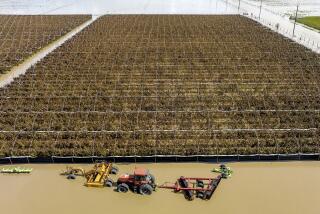BELL GARDENS : Children Tested for Lead Poisoning
Five-year-old Reyna Montano avoided looking at the needle that poked her arm. Her brown eyes widened and blinked hard once as a health worker drew her blood.
In less than a minute, it was over. Reyna smiled widely at her mother as an aide applied a “Little Mermaid” bandage.
Reyna was one of 118 children 6 or younger who were tested last week at Colmar Elementary School as part of a county Department of Health Services program to determine if they have been exposed to high levels of lead, possibly from a nearby smelting plant.
The neighborhood is about a block from the Daelco Division, Quenell Inc. plant at 5909 E. Randolph St. in the City of Commerce and was targeted for its proximity to the smelter. The plant has met Air Quality Management District standards for lead emissions.
The program, funded with a $148,500 grant from the state Environmental Protection Agency, is the first test in Southern California to examine the effects of a stationary lead source on children, said Amy Wohl, principal investigator for the pediatric lead project.
Parents should have their children’s test results within three weeks, Wohl said. If a child has unusually high blood lead levels, health officials will visit the home to try to determine the source of contamination and will direct parents to appropriate medical care.
Almost everyone is exposed to lead in the environment, said county health officer Arturo Olivas. Young children are particularly susceptible to lead poisoning, absorbing up to 50% of the lead they ingest, Olivas said.
The Centers for Disease Control recommends that all children get a blood lead test when they are six months old. By the time they are school age, “the damage is done,” Olivas said.
Even a paint chip the size of an adult’s thumbnail can cause lead poisoning when eaten by a young child, Wohl said. “With lead poisoning in small children, you typically see problems that are not readily apparent--behavioral problems, brain damage, hearing impairment,” she said.
Parents waiting nervously for their children to be tested listened as Olivas explained how they could make their homes safer. Emissions from vehicles and certain industries leave lead particles in water, soil and house dust, he said. Colored ink in newspapers and magazines also contains lead, he said.
Imported pottery fired with certain glazes should not be used for cooking or storing food, Olivas said. Chips of house paint are a leading hazard, and powdered home remedies often used in Latino households--such as greta and azarcon --can cause lead poisoning. He encouraged families to clean toys, floors and windowsills frequently to eliminate house dust that could contain lead.
“Parents think the danger is only from living near industry in an urban environment,” Olivas said. “They don’t realize that things they use every day could be a danger.”
Health officials also have tested children in Hacienda Heights and will conduct tests in South-Central later this month, Wohl said. In Hacienda Heights, children’s blood lead levels were found to be normal for youngsters living in an urban area, and officials expect similar results in Bell Gardens.
More to Read
Sign up for Essential California
The most important California stories and recommendations in your inbox every morning.
You may occasionally receive promotional content from the Los Angeles Times.










